When Houston’s unforgiving heat pushes energy bills through the roof and your AC runs around the clock, improving system efficiency isn’t optional—it’s essential. At 75 DegreeAC, our certified technicians have helped thousands of Houston homeowners reduce energy consumption by 15-30% through proven efficiency strategies. From simple thermostat adjustments to professional maintenance protocols, these expert-backed tips deliver measurable results that protect both your comfort and your wallet. With Houston’s extreme climate demanding year-round cooling, every efficiency improvement directly impacts your bottom line and extends your system’s lifespan.
Understanding HVAC Efficiency in Houston’s Climate
Houston’s hot and humid environment creates unique challenges for air conditioning systems. The average Houston home uses approximately 2,365 kWh of electricity annually just for cooling, though poorly insulated or larger homes can consume up to 12,340 kWh per year. This extreme usage means that even small efficiency improvements translate into substantial savings. The combination of temperatures regularly exceeding 95°F and humidity levels that strain dehumidification systems forces Houston HVAC units to work harder than systems in milder climates.
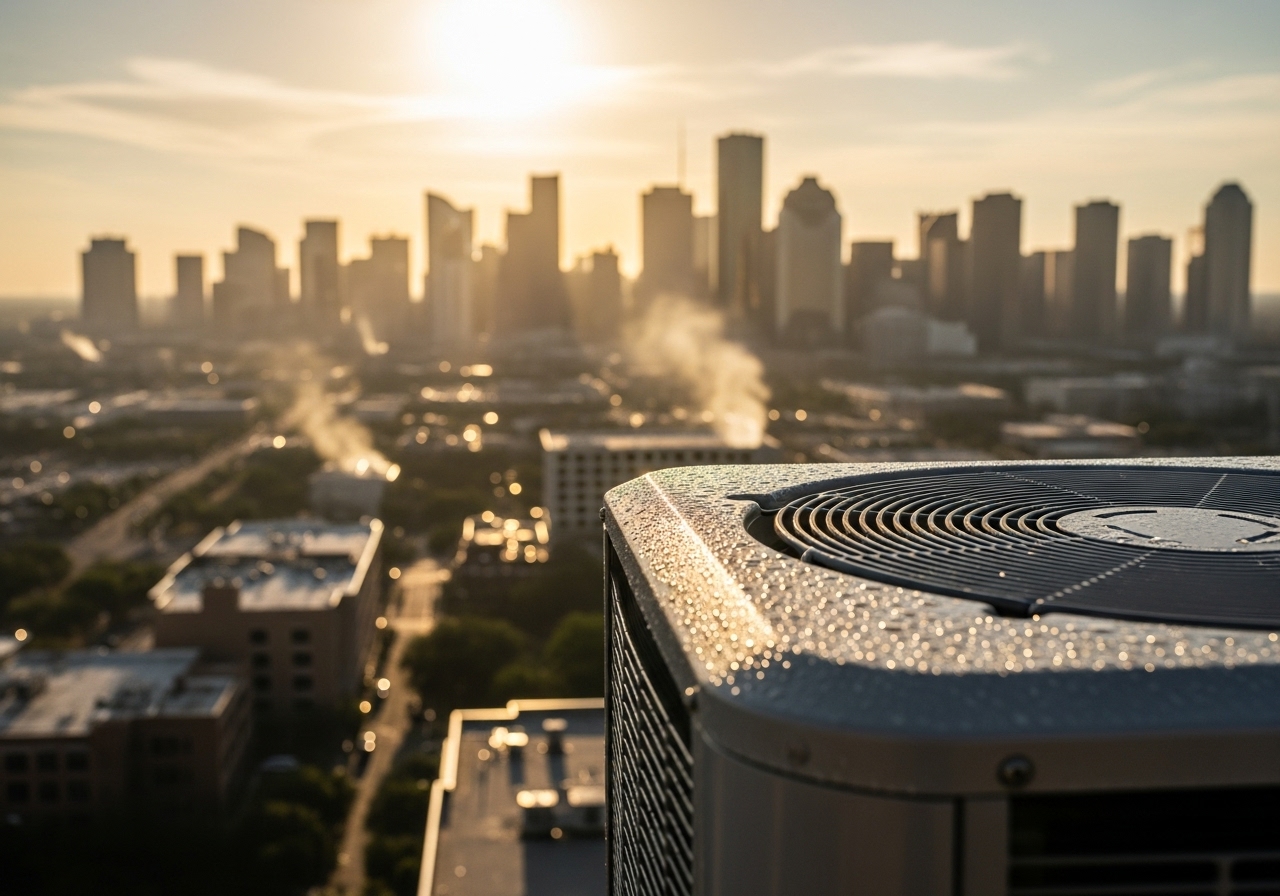
Houston’s year-round cooling demands mean that AC units typically last 10-15 years compared to 15-20 years in moderate climates. However, with proper maintenance and efficiency optimization, you can extend your system’s lifespan significantly while reducing the constant strain that Houston weather places on HVAC equipment. Understanding how your system responds to this demanding environment is the first step toward meaningful efficiency gains.
Upgrade to High-Efficiency Equipment
SEER Ratings and Energy Savings
The Seasonal Energy Efficiency Ratio (SEER) rating directly determines how much energy your air conditioner consumes. Modern high-efficiency units with SEER ratings of 16 or higher use significantly less electricity than older 13 SEER systems. According to Department of Energy data, upgrading from a 13 SEER to a 16 SEER system can reduce cooling costs by approximately 23%. ENERGY STAR certified air conditioners use up to 15% less energy than standard models, resulting in average savings of $70-100 annually on utility bills.
For Houston homeowners, investing in equipment rated 18 SEER or higher delivers optimal performance in extreme heat. These advanced systems incorporate variable-speed compressors and two-stage cooling that adjust output to match demand rather than cycling on and off repeatedly. This technology not only saves energy but also provides superior humidity control—critical for Houston’s muggy climate. When considering a new AC installation, prioritize high SEER ratings for long-term savings that offset the initial investment within 5-7 years.
ENERGY STAR Certification Benefits
ENERGY STAR certified systems meet strict efficiency criteria established by the Environmental Protection Agency. These units deliver enhanced performance, better temperature control, quieter operation, and improved humidity management. If all room air conditioners sold in the United States were ENERGY STAR certified, consumers would save approximately $1 billion annually while preventing 12.5 billion pounds of greenhouse gas emissions. Many utility companies offer rebates ranging from $150-$500 for installing ENERGY STAR equipment, making upgrades more affordable for Houston homeowners seeking both performance and savings.
Implement Smart Thermostat Technology
Smart thermostats represent one of the most cost-effective efficiency upgrades available. Independent studies demonstrate that smart thermostats reduce cooling electricity usage by 13.9% on average, with savings ranging from 9-19% depending on home characteristics and usage patterns. These devices learn your schedule and preferences, automatically adjusting temperatures when you’re away or sleeping to minimize energy waste without sacrificing comfort.
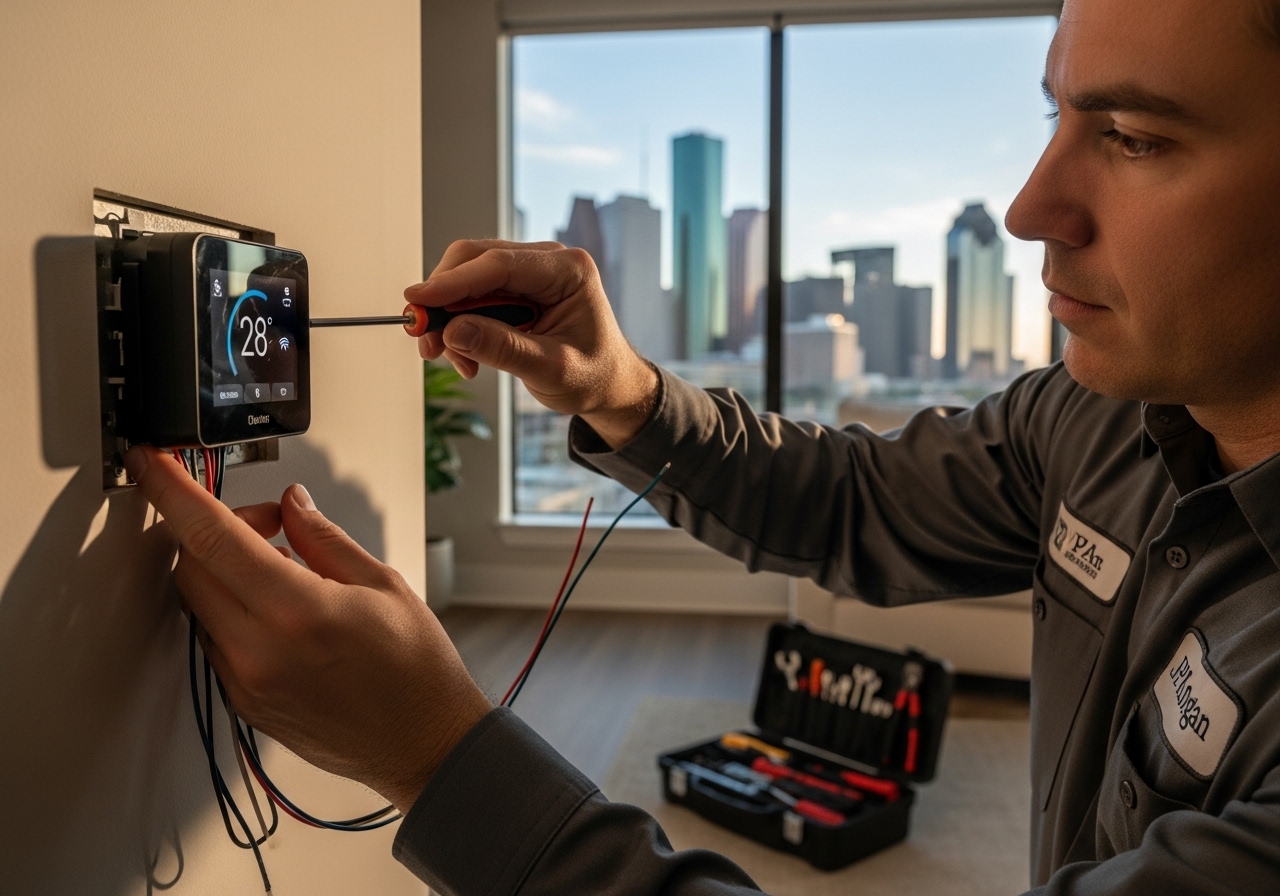
For optimal Houston performance, set your smart thermostat to 78°F when home and increase it by 5-7 degrees when away. Smart thermostats provide detailed energy consumption reports that identify exactly when and how your system uses electricity, allowing you to make informed adjustments. Remote control via smartphone apps ensures you never cool an empty house, while geofencing features detect your location and adjust settings automatically. Professional thermostat installation ensures proper calibration and integration with your existing HVAC system for maximum efficiency gains.
Schedule Regular Professional Maintenance
The 20% Efficiency Factor
Regular professional maintenance is the single most impactful action for maintaining peak efficiency. A well-maintained system runs 15-20% more efficiently than a neglected one, directly reducing energy bills and preventing costly emergency repairs. Houston’s extreme climate demands bi-annual maintenance—once in spring before peak cooling season and again in fall. Professional technicians perform comprehensive inspections that identify inefficiencies before they escalate into major problems.
Comprehensive AC maintenance includes cleaning evaporator and condenser coils, checking refrigerant levels, tightening electrical connections, lubricating moving parts, inspecting ductwork for leaks, calibrating thermostats, and testing system controls. Dirty coils alone can reduce system efficiency by 30% or more, while low refrigerant levels force your compressor to work harder and consume excess electricity. Annual maintenance extends equipment lifespan by 5-10 years and reduces the likelihood of breakdowns during Houston’s hottest months when you need reliable cooling most.
Filter Replacement Schedule
Air filter maintenance is the simplest yet most frequently neglected efficiency task. In Houston’s dusty, pollen-heavy environment, filters should be inspected monthly and replaced every 1-3 months depending on usage and air quality. Clogged filters restrict airflow, forcing your system to work 15% harder and consume proportionally more energy. High-efficiency pleated filters capture more particulates while maintaining proper airflow, improving both efficiency and indoor air quality simultaneously.
Optimize Airflow and Ductwork
Seal Duct Leaks
Ductwork leaks represent one of the most significant yet hidden sources of energy waste. Studies show that typical duct systems lose 20-30% of conditioned air through gaps, holes, and poorly sealed connections. In Houston’s attic environments where temperatures can exceed 130°F, leaking ducts force your system to cool superheated air constantly. Professional duct sealing using mastic sealant or metal tape eliminates these losses, improving overall system efficiency by up to 20%.
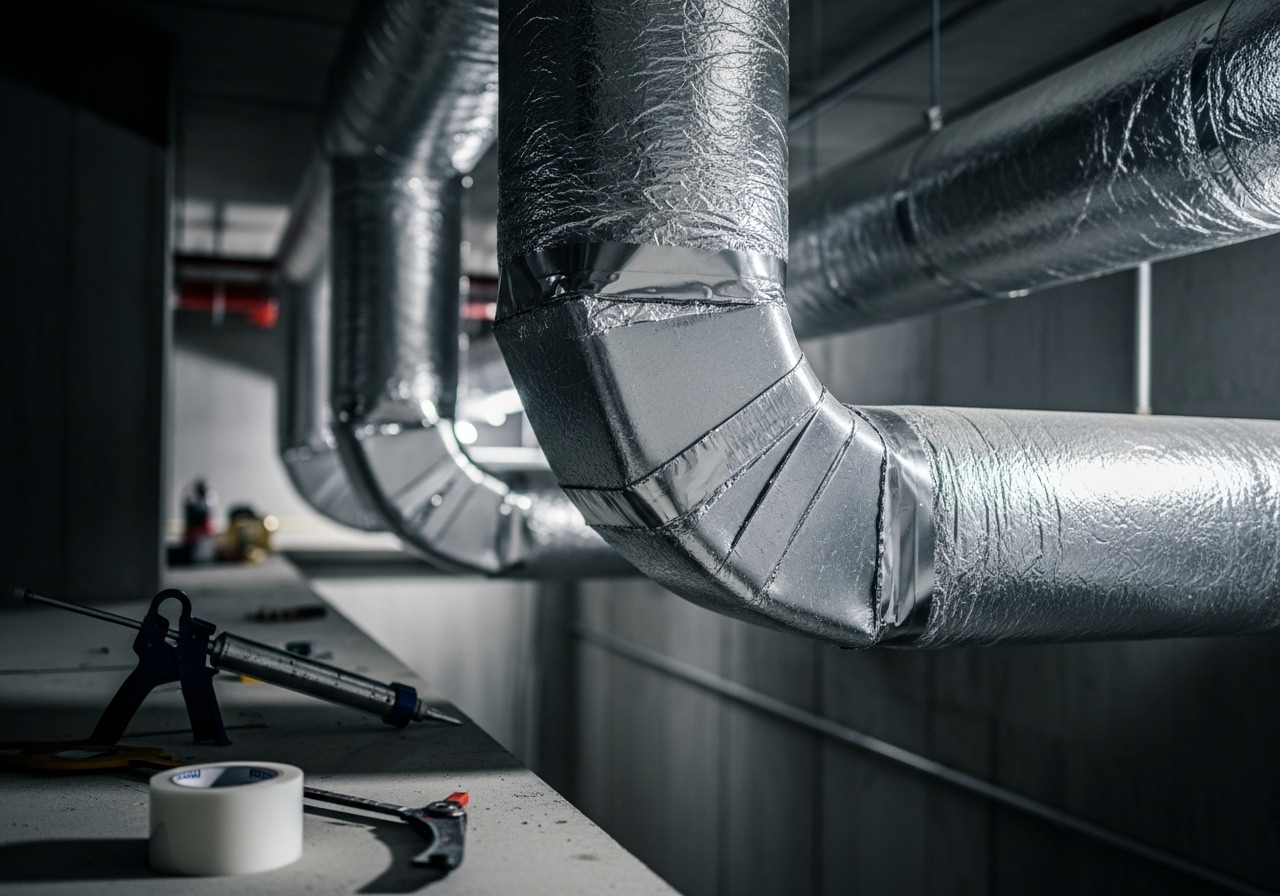
Proper duct insulation is equally critical, particularly for ductwork running through unconditioned spaces like attics or crawl spaces. Insulated ducts prevent temperature gain before air reaches your living spaces, ensuring maximum cooling effectiveness. Professional duct inspection identifies compromised sections that require sealing or replacement, delivering immediate efficiency improvements that reduce monthly cooling costs by $50-150 in Houston’s climate.
Improve Home Insulation
Adequate insulation prevents cool air from escaping and hot outdoor air from infiltrating your home. Attic insulation rated R-30 to R-60 is recommended for Houston homes, creating a thermal barrier that reduces cooling loads by 15-25%. Weatherstripping around doors and windows eliminates air leaks that waste energy, while proper sealing of penetrations for pipes, wires, and vents prevents conditioned air loss. These improvements complement HVAC efficiency by reducing the total cooling demand your system must meet.
Implement Strategic Cooling Practices
Zone Control Systems
Zoning systems divide your home into separate temperature zones with independent thermostats and motorized dampers controlling airflow to each area. This technology allows you to cool only occupied spaces rather than maintaining consistent temperatures throughout the entire house. For larger Houston homes or those with complex layouts, zoning reduces energy consumption by 20-35% by eliminating waste associated with cooling unused rooms.
| Efficiency Strategy | Energy Savings | Implementation Cost | Payback Period |
|---|---|---|---|
| Smart Thermostat | 9-19% | $150-$300 | 2-3 years |
| Regular Maintenance | 15-20% | $150-$250/year | Immediate |
| Duct Sealing | 15-25% | $300-$800 | 1-2 years |
| High SEER Upgrade | 20-30% | $7,000-$11,500 | 5-7 years |
| Zoning System | 20-35% | $2,000-$5,000 | 3-5 years |
Ceiling Fan Supplementation
Ceiling fans create a wind-chill effect that makes rooms feel 4°F cooler without actually lowering air temperature. This allows you to raise your thermostat setting by 4 degrees while maintaining the same comfort level, reducing cooling costs by approximately 8-12%. Ensure fans rotate counterclockwise during summer to push air downward, and remember that fans cool people, not rooms—turn them off in unoccupied spaces to avoid wasting electricity on motor operation.
Address Heat Sources and Solar Gain
Window Treatments and Solar Control
Windows account for 25-30% of residential cooling loads in Houston’s intense sun. Installing reflective window film, cellular shades, or solar screens blocks heat gain before it enters your home, reducing cooling demands by up to 25%. Close blinds and curtains on south and west-facing windows during afternoon hours when solar radiation peaks. Light-colored exterior window treatments reflect heat away from your home rather than absorbing it, providing passive cooling that reduces HVAC workload throughout the day.
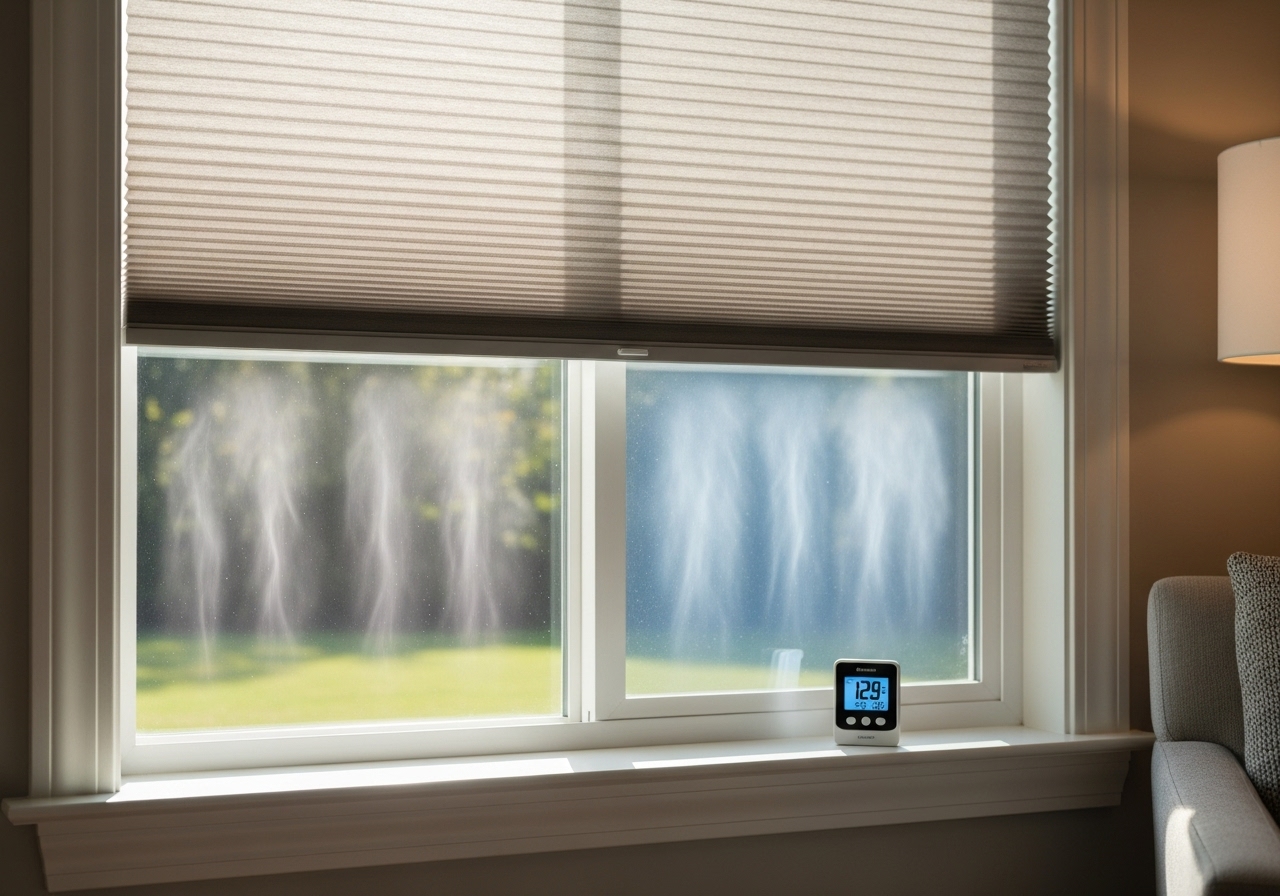
Minimize Internal Heat Generation
Household activities generate surprising amounts of internal heat that your AC must remove. Use heat-generating appliances like ovens, dishwashers, and dryers during cooler evening hours rather than peak afternoon heat. Switch to LED lighting which produces 75% less heat than incandescent bulbs while using less electricity. Ensure kitchen and bathroom exhaust fans vent outdoors to remove heat and humidity directly rather than allowing your HVAC system to condition that air.
Monitor and Optimize System Performance
Energy Audits and Professional Assessment
Professional energy audits identify specific inefficiencies in your home’s cooling system and building envelope. Thermal imaging cameras reveal insulation gaps, air leaks, and areas where conditioned air escapes. Blower door tests measure overall home tightness and quantify air infiltration rates. These comprehensive assessments provide data-driven recommendations prioritized by cost-effectiveness, allowing you to address the most impactful inefficiencies first for maximum return on investment.
Regular Performance Monitoring
Monitor your system’s performance through monthly utility bill tracking and smart thermostat energy reports. Sudden increases in energy consumption indicate developing problems requiring professional attention. Listen for unusual noises, watch for frozen coils or ice formation, and note whether your system cycles excessively or runs continuously without reaching set temperatures. Early detection of efficiency problems prevents minor issues from escalating into costly repairs while ensuring your system maintains optimal performance throughout Houston’s extended cooling season.
Advanced Efficiency Technologies
Variable Speed and Two-Stage Systems
Variable speed air handlers and two-stage compressors represent significant technological advances in HVAC efficiency. Unlike single-stage systems that operate at 100% capacity or off, variable speed equipment adjusts output from 40-100% to match precise cooling demands. This results in longer run cycles at lower speeds, superior humidity removal, more consistent temperatures, quieter operation, and 20-40% energy savings compared to conventional single-stage equipment.
Ductless Mini-Split Systems
For homes without existing ductwork or room additions where extending ducts is impractical, ductless mini-split systems offer exceptional efficiency. These systems eliminate duct losses entirely while providing zone control as an inherent feature. Modern mini-splits achieve SEER ratings of 20-30, significantly exceeding conventional central systems. They’re ideal for Houston garages, home offices, sunrooms, or older homes where installing ductwork would be prohibitively expensive or architecturally impossible.
Cost-Benefit Analysis of Efficiency Improvements
Strategic efficiency investments deliver cumulative savings that compound over time. A Houston homeowner implementing smart thermostat technology (9-19% savings), bi-annual professional maintenance (15-20% savings), and proper duct sealing (15-25% savings) can realistically reduce total cooling costs by 35-50%. For a typical Houston home spending $2,400 annually on cooling, these measures save $840-$1,200 per year—a substantial return that justifies initial investment costs within 12-24 months.
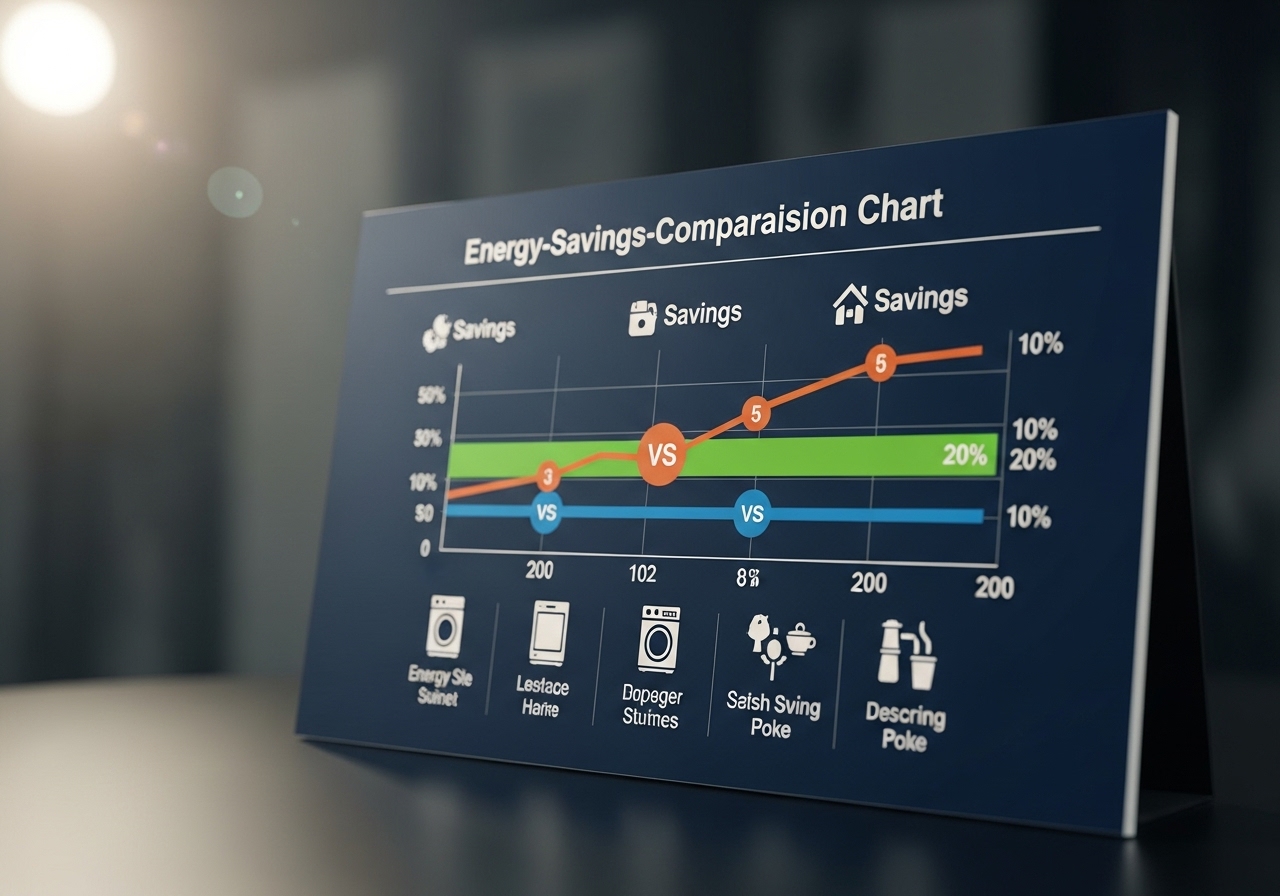
Long-term benefits extend beyond immediate utility savings. Reduced system runtime decreases wear on components, extending equipment lifespan by 3-7 years and delaying expensive AC replacement costs. Improved efficiency enhances indoor comfort through better humidity control and more consistent temperatures. Enhanced home value and marketability result from documented energy-efficient upgrades that appeal to environmentally conscious buyers.
Professional vs. DIY Efficiency Improvements
While homeowners can handle basic tasks like filter replacement and thermostat programming, professional expertise is essential for significant efficiency gains. Certified HVAC technicians possess specialized tools, training, and experience to diagnose complex efficiency issues that aren’t apparent to untrained observers. Refrigerant handling requires EPA certification due to environmental regulations, while electrical work must meet code requirements for safety and insurance purposes.
Professional AC repair services identify root causes rather than symptoms, preventing recurring problems that waste energy and money. Licensed contractors provide warranties on work performed, protecting your investment and ensuring quality results. For Houston homeowners seeking maximum efficiency improvements with minimal risk, partnering with established professionals like 75 DegreeAC delivers superior outcomes backed by proven expertise and industry-leading service guarantees.
Seasonal Efficiency Strategies for Houston
Houston’s extended cooling season demands year-round efficiency awareness. Spring preparation includes scheduling professional maintenance, replacing filters, cleaning outdoor units, trimming vegetation around condensers, and testing system operation before peak demand arrives. Summer operation focuses on consistent thermostat settings, minimizing door and window openings during peak heat, and monitoring system performance for signs of declining efficiency requiring immediate attention.
Fall transition provides opportunities to reassess insulation, seal air leaks identified during summer operation, and perform second annual maintenance before brief heating season begins. Even during mild winter months, maintaining HVAC system readiness ensures optimal performance when cooling demands return. This proactive seasonal approach prevents efficiency degradation while maximizing equipment longevity and performance throughout Houston’s demanding climate cycle.
Conclusion: Maximize Comfort and Minimize Costs
Improving HVAC efficiency in Houston requires a comprehensive approach combining equipment upgrades, professional maintenance, smart technology, and strategic operational practices. These proven strategies deliver measurable results—reducing energy consumption by 35-50% while extending equipment lifespan and enhancing indoor comfort. The cumulative benefits of efficiency improvements far exceed initial investment costs, providing ongoing savings that compound year after year in Houston’s demanding climate.
At 75 DegreeAC, our certified technicians deliver expert guidance and professional service that transforms inefficient systems into optimized, high-performance cooling solutions. We understand Houston’s unique challenges and provide tailored recommendations that maximize efficiency based on your home’s specific characteristics and your family’s comfort needs.
Ready to reduce your energy bills and improve system performance? Contact 75 DegreeAC today at (713) XXX-XXXX for a comprehensive efficiency assessment and discover how much you can save with professional optimization services designed specifically for Houston’s extreme climate.
Frequently Asked Questions
How much can I save by improving my AC’s efficiency in Houston?
Houston homeowners typically save 35-50% on cooling costs by implementing comprehensive efficiency improvements including smart thermostats, professional maintenance, duct sealing, and high-efficiency equipment. For an average Houston home spending $2,400 annually on cooling, this translates to $840-$1,200 in yearly savings. Individual results vary based on home size, insulation quality, existing equipment efficiency, and usage patterns.
How often should I schedule professional AC maintenance in Houston?
Houston’s extreme climate demands bi-annual professional maintenance—once in spring before peak cooling season and again in fall. This schedule prevents efficiency degradation, identifies developing problems early, and ensures optimal performance during months of continuous operation. Regular maintenance improves efficiency by 15-20% and extends equipment lifespan by 5-10 years compared to neglected systems.
What SEER rating should I choose for Houston’s climate?
For Houston’s hot, humid climate with year-round cooling demands, choose systems rated 16 SEER or higher. Units rated 18-20 SEER provide optimal efficiency and superior humidity control, delivering maximum long-term savings despite higher initial costs. The intense usage in Houston means higher-efficiency systems pay for themselves faster through reduced utility bills compared to moderate climates with seasonal use.
Do smart thermostats really save energy?
Yes. Independent studies demonstrate that smart thermostats reduce cooling electricity consumption by 13.9% on average, with documented savings ranging from 9-19%. These devices optimize temperature settings based on occupancy and schedule, eliminate cooling empty homes, provide detailed energy reports, and allow remote control—all contributing to measurable efficiency improvements that translate directly into lower utility bills.
Can I improve efficiency without replacing my entire AC system?
Absolutely. Professional maintenance, smart thermostat installation, duct sealing, improved insulation, and strategic operational practices deliver 30-40% efficiency improvements without equipment replacement. These cost-effective measures extend your existing system’s lifespan while reducing energy consumption significantly. When your system eventually requires replacement, these improvements ensure maximum performance from new equipment.
How do I know if my ductwork is leaking?
Signs of duct leakage include uneven cooling between rooms, excessive dust accumulation, unusually high energy bills, rooms that never reach set temperatures, and visible gaps or disconnected sections in accessible ductwork. Professional duct testing using blower door tests and pressure measurements quantifies exact leakage rates and identifies specific problem areas requiring sealing for optimal efficiency restoration.

